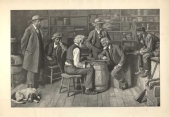The Checker Maven
The World's Most Widely Read Checkers and Draughts Publication
Bob Newell, Editor-in-Chief
Published every Saturday morning in Honolulu, Hawai`i
Noticing missing images? An explanation is here.
Logical Checkers Vol. 3: Two-Move Expert
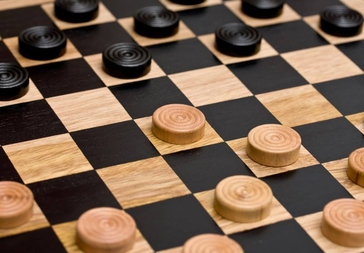
Today we're delighted to announce the immediate availability of the third volume of Grandmaster Richard Pask's Logical Checkers series, subtitled Checkers for the Two-Move Expert. In this new book, which runs to close to 300 pages, Mr. Pask presents new material on endgames, landings, and a vast array of tactical themes, as well as a survey and analysis of two-move ballots (as a stepping-stone to eventual study of three-move ballots).
You can get the book from the Richard Pask page as linked in the right-hand column, or directly here. The book is of course completely free of charge thanks to the generosity of Mr. Pask.
As a bit of a teaser, here's a position found in the book. It's one of Mr. Pask's own devising which he calls Life's Not Fair.
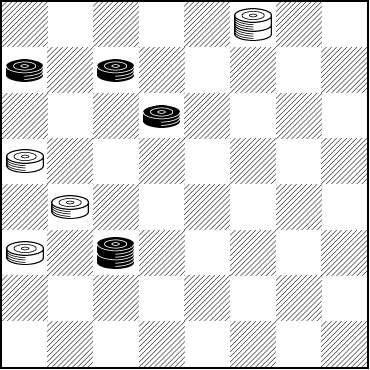
WHITE
White to Play and Win
W:WK3,13,17,21:B5,6,10,K22
To see the solution, download the book and go to Diagram 391 on page 92.
The Checker Maven thanks Mr. Pask for the continuing privilege of editing and presenting his work.![]()
A Cakewalk
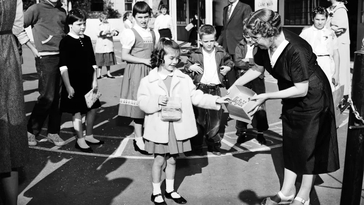
The Cakewalk goes back a long way, and is intimately connected with Black history and pre-Civil War southern plantation life. But today, a Cakewalk is something of a carnival game, something like musical chairs but with a cake as the prize. The word has also come to mean something that is extremely easy to do or accomplish.
And no, today's column doesn't have anything to do with our ongoing Coffee and Cake series; we've chosen the title Cakewalk because today's problem is very easy indeed. It's so easy that we've resurrected our long-neglected Javascript timer.
Expert players will take longer to read the terms of the problem than they will to solve it; an instant solution is likely. Even intermediates will solve it just about at once. Beginners may have to reflect a few seconds but they too should not have much trouble.
Why such an easy problem? Well, we present hard ones week after week and once in a while we think it's good to go in the other direction. Players of all levels should find a home in our columns. The position was sent to us by regular contributors Lloyd and Josh Gordon of Toronto and arose over the board.
So here we go. Click below to show the problem and start the clock.
Cakewalk (very easy)
Got it? Of course you did. But click on Read More all the same, just to be sure.![]()
Season Opener

It was Opening Day for the National Checker League as the 2019-2020 season was about to begin, and Marvin J. Mavin, Captain of the defending champion Detroit Doublejumpers, was ready.

Marvin J. Mavin
August training camp had been rough, with lots of physical and mental training. But Marvin had to admit it felt good to be in top shape, even though he thought the coaches had been pretty tough on him. No beer for a whole month, and running laps constantly.

This afternoon, the Doublejumpers were facing the Seattle Single Corners at Starbugs Stadium in Seattle. A sellout crowd of over 50,000 was on hand to see what promised to be an exciting contest.

Marvin, on first board, was paired up against the Seattle captain, a short, squat fellow that just went by the name Sluggo. In high school and college, Sluggo was a champion weight lifter and wrestler, but he was so good at checkers that he decided to take a pro contract. Still, one look at him told you that he had definitely kept up the physical training.
Word had gotten around the League about Marvin's experiences in training camp this year, and Sluggo started to ride Marvin as soon as they took their places across the checkerboard.
"Heard you had to run some laps," Sluggo said. "Must a been tough for a wimp like you." Sluggo laughed, a deep, nasty sound that had intimidated many an opponent both over the board and in the ring.
"Yeah, well, unlike you I got a brain," Marvin said.
"Not very original," Sluggo replied, "and anyhow you won't have one yourself after I bust up your head."
"Hey! Are you threatening me? You can't do that!"
Sluggo looked Marvin right in the eye. "Really? Whatcha gonna do about it?" Sluggo raised his clenched fists to chest level.
Marvin involuntarily took a step back, but just then the referee's whistle blew and the call "Play checkers!" resounded across the field.

Sluggo stuck out his hand for a handshake, but Marvin didn't take it. He was afraid Sluggo would break his fingers. That got another low laugh from Sluggo. "Have it your way, little boy," he said. "I'll beat you on the board, over the board, and into the board."
The game proceeded as follows. Marvin had Black and Sluggo had White.
| 1. | 11-16 | 23-18 |
| 2. | 10-15 | 18x11 |
| 3. | 8x15 | 24-19 |
| 4. | 15x24 | 27x11 |
| 5. | 7x16 | 28-24 |
| 6. | 4-8 | 22-18 |
| 7. | 8-11 | 26-23 |
| 8. | 16-20 | 31-27 |
| 9. | 6-10 | 18-14 |
| 10. | 10x17 | 21x14 |
| 11. | 9x18 | 23x14 |
| 12. | 11-15 | 30-26 |
| 13. | 3-7 | 26-23 |
| 14. | 1-6 | 25-21 |
Loses. 25-22 was correct.
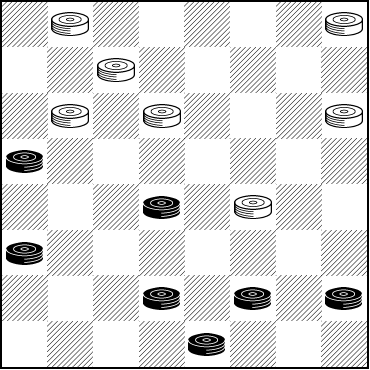
BLACK
Black to Play and Win
B:W14,21,23,24,27,29,32:B2,5,6,7,12,15,20
Marvin chuckled. "Hey, you did pretty well up to now--- for a lamebrain. But that last move is gonna cost you the game."
"Oh yeah?" replied Sluggo. "Sez who?"
"Sez me, Marvin J. Mavin."
"You're dead meat. Nobody beats Sluggo."
Marvin chuckled again. "We'll see about that," he said, and made his move.
Can you beat Sluggo? No, not on a wrestling mat, but over the board? See if you can find the win and then slam your mouse on Read More to see the solution and the conclusion of our story.![]()
Hogan's Heros
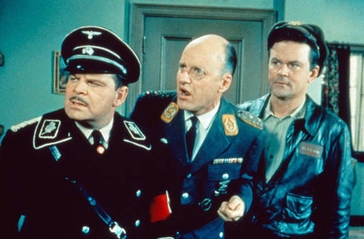
Hogan's Heros was an American television program that ran from 1965 through 1971. It was pretty popular in its time, although today's politically correct, looking-to-be-offended crowd would find it unacceptable.
But there was a different and earlier Hogan, namely E. W. Hogan of Emo, Ontario, who is a hero to us in a checker sort of way. Some time in the latter part of the 1930s he published a problem that to this day is a bit resistant to computer solution. Take a look at the diagram below.
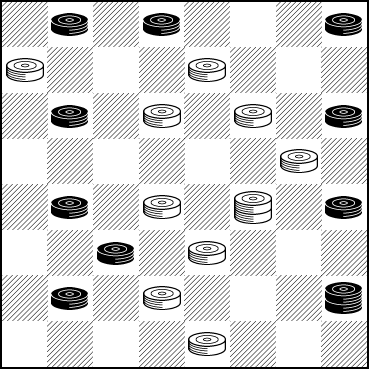
WHITE
White to Play and Win
W:W5,7,10,11,16,18,K19,23,26,31:B1,2,4,9,12,17,20,22,25,K28
Yes, the KingsRow computer engine found the solution ... but it did have to think about it for a few seconds (normally KingsRow solves positions virtually instantaneously).
So we think you'll find it to be an interesting challenge. Don't worry about being politically correct; become one of E. W. Hogan's heros and try to solve it. When you're ready, click on Read More to see the solution.![]()
One Last Gem

For the last several months our monthly Checker School columns have been featuring "gem" problems. Whether or not they were all truly "gems" is for you, our reader, to decide, but we have one last entry in the current series to present to you today. It's by S. J. Pickering and apparently first made its appearance in the old (and excellent) checker magazine Elam's Checker Board.
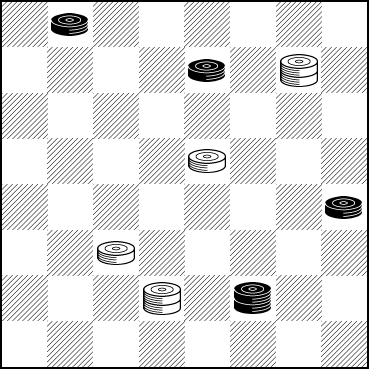
WHITE
White to Play and Win
W:WK8,15,22,K26:B1,7,20,K27
White has two kings to Black's one and has a centralized position. Should be easy, shouldn't it? But checkers is subtle and complex, and the win may not be so simple.
Does this one sparkle for you? Can you appreciate its facets? See if you can solve it and then let your mouse shine on Read More to see the solution and notes.![]()
You Did What?
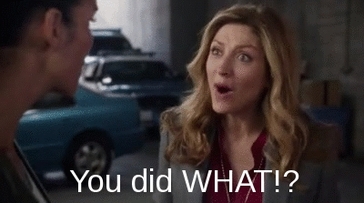
Uh-oh. Someone is in deep trouble. That fellow is going to have to work very hard and very quickly to find a draw and avoid a loss, so to speak.
Of course, things like this come up in checkers all the time. We make a move and then wish we had made another. Sometimes the draw is still there, and sometimes not. Take a look at the position below.

BLACK
Black to Play, White to Draw
B:WK9,23,26,27,30:B13,14,16,18,19
White has just played 6-9. It looks logical at first glance, doesn't it? Actually, the move is sound if maybe not optimal, but as usual, playing it out over the board is the real issue. This quick little study is based on a position sent to us by regular contributors Josh and Lloyd Gordon of Toronto. It's not quite a speed problem, but it isn't too hard if you keep your wits about you.
Stay out of trouble; solve the problem and be able to say the much more positive phrase, "I did it!" You can always click on Read More to check your solution.![]()
Shardlow: Checker Friendy?

Shown above is what is now a pub called The Clock Warehouse in Shardlow, Derbyshire, England. The pub is said to be dog-friendly. We're not quite sure what that means. We would rather have heard that the pub was checker (draughts) friendly.
Today, we consider a problem by a checkerist named Shardlow who didn't come from England, but from Marshall, Minnesota. What was his connection, if any, with the town in England? Most likely there is none, though we'll probably never know.
Mr. F. C. Shardlow published a number of problems in various newspapers; the one below appeared in The Winnipeg Free Press in 1938. All we were able to turn up about the author was that his full name was Frederick Cromwell Shardlow, that he was born in 1874, passed on in 1948, and had a wife and two daughters. We didn't find anything additional about his checker career, although he obviously must have been quite good.
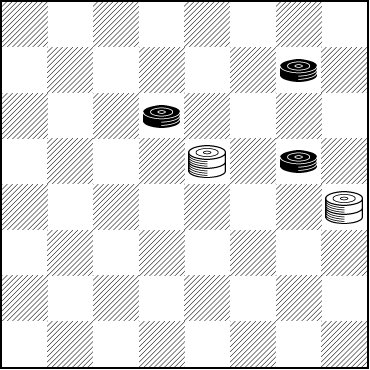
WHITE
White to Play and Win
W:WK15,K20:B8,10,16
A checker friendly problem? We think so. Try to solve it, and then give a friendly click of the mouse on Read More to see the solution.![]()
Summer's End
It was the end of summer, and Sal had really missed the weekly gatherings of the Coffee and Cake Checker Club. Saturday afternoons just weren't the same without stopping by the Beacon Cafe for a couple of hours of checker fun with the rest of the boys. But summers in Bismarck, North Dakota were short, and most indoor activities knocked off from just before Memorial Day until just after Labor Day.
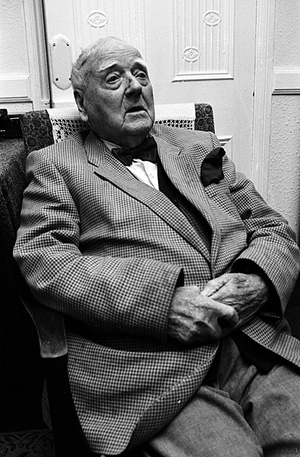
Sal
On the last Saturday of August, 1955, Sal just couldn't resist grabbing a checker magazine and walking over to the Beacon. He didn't expect anyone else from the Club to be there, but he'd be content to enjoy some of Deana's coffee and cake on his own. Deana was the proprietor of the Beacon and her desserts were the best in town.
He sat down in a small booth and was soon occupied with a cup of coffee and some of the games and problems in the August edition of All Checkers Digest.
He was deep into an article about the big July tournament in Las Vegas, which had drawn over a thousand players from all over North America, when he felt a tap on his shoulder.
"Hey, what are you doing here?" a voice said.

Louie the Flash
Sal looked up, and gosh-darn if it wasn't Louie from the Club!
"Could ask you the same," Sal said with a grin.
"I was painting the guest bedroom all morning," Louie said, "and my wife told me, 'Go treat yourself to something at the Beacon.' Well, couldn't pass that up now, could I?"

"Deana's got chocolate chip bars," Sal said. "Want to buy me one, Flash?" Louie had somehow gotten the nickname "Louie the Flash" and it had stuck.
"Me buy you one?" Louie replied. "Come on, dig a problem out of that there magazine and we'll see who buys!"
Sal chuckled. "Just happens there's one in here from my pal Brian," he said. "Coffee and cake on you when you can't win it?"
"Coffee and cake on you when I do win it," Louie said. But he wasn't really so sure. Brian always sent Sal problems, but the ones that he had published in a major checker magazine with nearly a million readers were usually pretty tough.
"Well, then, Flash old boy, here you go."
Sal set up the following position on his board.
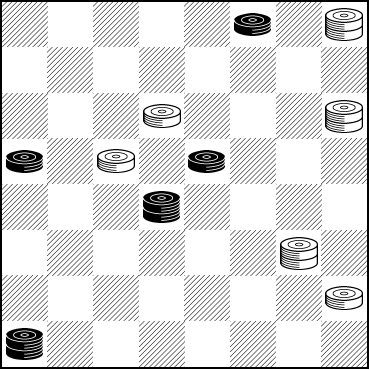
WHITE
White to Play and Win
W:WK4,10,K12,14,K24,28:B3,13,15,K18,K29
After a few minutes, Louie said, "You gotta be kidding me."
"Can't do it, can you?" Sal said. But then he noticed Louie's big grin. "What's the deal with the smile, Flash?"
Louie started to move the checkers.
Did Louie find the problem too hard or to easy? He probably wouldn't be grinning if he hadn't solved it. How about you? Will you grin or frown? See what you can do and then click on Read More for the solution and the conclusion of the story.![]()
Definitive Analysis of 11-Man Ballot

The eleven men above certainly aren't playing 11-man ballot or any other variety of checkers, though we'll bet many of them did surely play checkers in a slightly less risky environment.

But today, our subject is indeed the 11-man variant of checkers. Created around 1907 by champion player Newell W. Banks, it provided an inventive alternative to the common "go as you please" (GAYP) style, in the hopes of lending the game fresh variety and reducing the number of draws.
In GAYP, of course, there are no restrictions on opening moves. Players indeed go where and as they please. The relatively short-lived "2 move restriction" style, in which the first move for both Black and White is chosen by lot, was played for a while in the early 20th century; and "3-move restriction" in which the 3-move opening sequence Black-White-Black is randomly selected, came just a bit later and is current today. (GAYP is also still played at the highest levels of the game.)
The 11-move ballot variant got some play and some attention but never really caught on, at least not until recently, and while 3-move restriction has been extensively analyzed, 11-move ballot has remained mostly new territory.
For a full description of 11-man ballot, you can see this link, but the basic idea is that one piece chosen at random is taken off the board on each side, and then the first Black and first White move are also chosen at random. There are some further rules and limitations, but that's the main idea. There are 2,500 independent ballots in this variation! Some are known to be dead lost (and are not played), many are clearly playable, and some are open to speculation.

Ed Gilbert
Photo Credit: Carol Gilbert
Until now. For Ed Gilbert and his mighty KingsRow computer engine have been very busy, and Mr. Gilbert has made yet another contribution to the game: he has analyzed and classified every last one of the 2,500 ballots, labeling each as won, lost or drawn for Black or White, and further, calculating a difficulty factor for all of them. This information is handily summarized in a series of tables (see links at the end of this article).
Ed has also prepared a special 11-man ballot computer opening book containing 1.1 million positions, which is now distributed with the latest download of KingsRow. He has made all of this material available free of charge on his website (again please see links at the end of this article).
11-man ballot will never be the same again.
What follows is a fairly detailed discussion of Ed's work. But first, to illustrate the depth of Ed's discoveries, take a look at the following position.
Remove 6 and 21; 12-16 22-18
WHITE

BLACK
Black to Play and Draw
B:W18,23,24,25,26,27,28,29,30,31,32:B1,2,3,4,5,7,8,9,10,11,16
This, gentle reader, is a draw. Yes, it is, requiring no less than 20 star moves on the part of Black. Ed ranks this as the toughest of all the 11-man ballots and we call it the toughest checker problem ever published.
Care to try it? You can access our no-spoilers animation here. Try to guess each Black star move and the strongest reply by White before you click the arrow to show the next move. If you can solve it, you're superhuman, but it's fun to try and will give you a real workout. If you'd rather just play through on a board or on your computer, you can click on Read More to see the list of moves.
And now let's let Ed describe his work in his own words, through a series of emails sent to us over the past few months. A bit earlier on in the process, Ed said this:

"I have finished the analysis work I've been doing on 11-man ballots.
"I have found a few more 11-man lost ballots. There are now 248 lost ballots identified by the opening book generator. This may be the exact right number, or perhaps I'm off by 1, I can't be absolutely sure, but it's been over a month of book expansion since the last lost ballot was identified, so I feel that the analysis is quite solid now. I read on the NC Checkers site that when they play an 11-man championship match, after selecting a ballot at random, the 2 players sometimes spend some time trying to determine if the ballot is playable or perhaps a loss. Maybe this analysis will at least be useful to simplify that part of the matches."
A little later on, Ed sent this update, wherein an additional ballot (the one diagrammed above) was found to be a draw rather than a white win, reducing the number of lost ballots to 247:
"Using a combination of engine matches and additional book expansion, I found that one of the 11-man openings that I had classified as a white win is actually a draw. It is ballot #2493, and a very difficult draw to be sure. When I updated the rating tables, this ballot went to the very top of the difficulty table with the highest difficulty figure of all the drawn ballots. It appears that for the first 20 moves, there is only one drawing move for black (when white plays the strongest attack)."
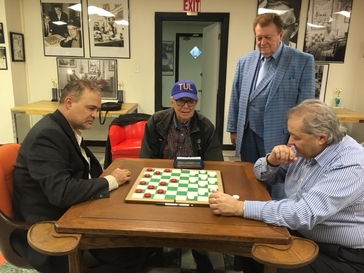
Finally, here are the details about how Ed computed difficulty rankings. To determine a reference for relative difficulty, Ed first re-analyzed the 3-move ballots and correlated various measures with the difficulty ratings assigned by Grandmaster Richard Pask and published on the ACF website (see link at bottom of article).
Warning: The following material is not for the faint of heart or the non-mathematical! (Note: The text below contains a small post-publication correction Ed sent us based on correspondence with Martin Fierz.)
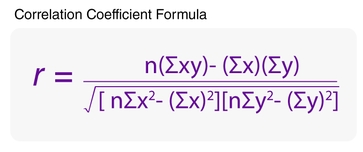
"Each position along the PV is visited, and a 5-second KingsRow search is done with KingsRow configured to use only an 8-piece endgame database. The sum of those search scores is the value used.
"By the way, I found that if I did the searches with a 10-piece database, the results did not correlate nearly as well as they do with 8-piece. Too many searches return 'database draw' using the 10-piece database, so too much heuristic information is lost that way. I should also mention that database draw search scores of +/-1 and repetition draw scores of +/-3 were given the value 0 during the PV sum process.
"'Match score difficulty' is the second rating value that is an independent input into the model. To get this value, a number of engine match games were played for each 11-man ballot. To be specific, each ballot was played for 96 games, KingsRow vs KingsRow, opening books off, 8-piece database, and blitz time controls of 0.1 seconds/move."
"This component of the model is based on a suggestion from Martin Fierz. I will paste exactly what he wrote to me, because I liked his reasoning and found it slightly amusing. He wrote, 'My feeling is that at 0.1s the engines are playing very well according to human standards, but not yet inhumanly well, so that this metric kind of approaches what strong human players would do when playing these ballots.'
"To turn the Black wins ('bwins'), White wins ('wwins'), and games into a ranking score, I used this logic:
if (bwins >= wwins)
rank = bwins / games
else
rank = -wwins / games
"I had previously tried other logic, like 'rank = (bwins + wwins) / games', but that metric by itself did not correlate as well with Richard Pask's ratings (for 3-move ballots). To put this into words, it seems that the Pask ratings are based primarily on his perception of how difficult it is for the weak side to play these ballots, and does not take into account that perhaps there are significant opportunities for the weak side to actually score a win. It didn't happen often, but you can see there are a few ballots where the weak side scored almost as many wins as the strong side.
"So we have these two rating values, PV sum and match score, and these were combined and a best fit to Pask's scaled ratings was found through linear regression. If you plot a best fit of each of these ratings to Pask's separately, you find that PV sum by itself has an R-squared value of 0.608.
"When the match score is used by itself to predict Pask's ratings, the R-squared value was much lower, something like 0.2. I also did this with the 'match score' ratings. So by themselves they would not provide a good model, but when combined it does increase the adjusted R-squared by nearly 0.1.
"The output of the linear regression module for the full model is the scaled ACF difficulty, and these coefficients are used directly to generate the 11-man difficulty ratings."
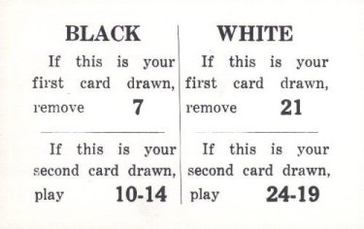
So there you have it. 11-man ballot has at long last been put on a solid footing based on detailed calculation and computer analysis. Is this the very last word on the topic? Ed himself would likely say that in checkers, the last word is never really in, but have we ever come a long way!
And some people think checkers is simple? After hundreds of years, we're still finding new ideas and exciting discoveries!
The Checker Maven thanks Ed Gilbert for the enormous privilege of presenting his work in this column. We hope Mr. Gilbert's ground-breaking efforts will serve to increase interest in 11-man ballot checkers, leading to more competition and even more analysis and publication.
Main link to Ed's work:
11-man ballot, descriptive page
The following links can also be reached from Ed's website but are given here for convenience.
Latest KingsRow which includes the 11-man ballot opening book
11-man ballot difficulty ratings in order of difficulty
11-man ballot difficult ratings in ballot number order
Reference rankings of 3-move opening difficulty (Richard Pask/ACF)
![]()
Give A Little, Get A Little

Exchanging gifts--- sometimes small, sometimes not so small--- is a long-standing tradition. Among family and friends, it makes no difference if we give a little more than we get, or get a little more than we give.
Not so, however, in our game of checkers. If we give, we'd better get back at least as much, if not more. and that leads us to this month's easy problem--- perhaps it isn't completely easy, but we've already given such a large hint that it should be simple enough. The position was provided by regular contributors Lloyd and Josh Gordon of Toronto.

BLACK
Black to Play and Draw
B:W12,18,19,21,23,26,27,28:B3,9,10,11,14,16,17,20
Will you be able to resolve the interesting give and take? Give it a try, then take your mouse over to Read More to see the solution.![]()
The Checker Maven is produced at editorial offices in Honolulu, Hawai`i, as a completely non-commercial public service from which no profit is obtained or sought. Original material is Copyright © 2004-2025 Avi Gobbler Publishing. Other material is public domain, as attributed, or licensed under Creative Commons. Information presented on this site is offered as-is, at no cost, and bears no express or implied warranty as to accuracy or usability. You agree that you use such information entirely at your own risk. No liabilities of any kind under any legal theory whatsoever are accepted. The Checker Maven is dedicated to the memory of Mr. Bob Newell, Sr.

